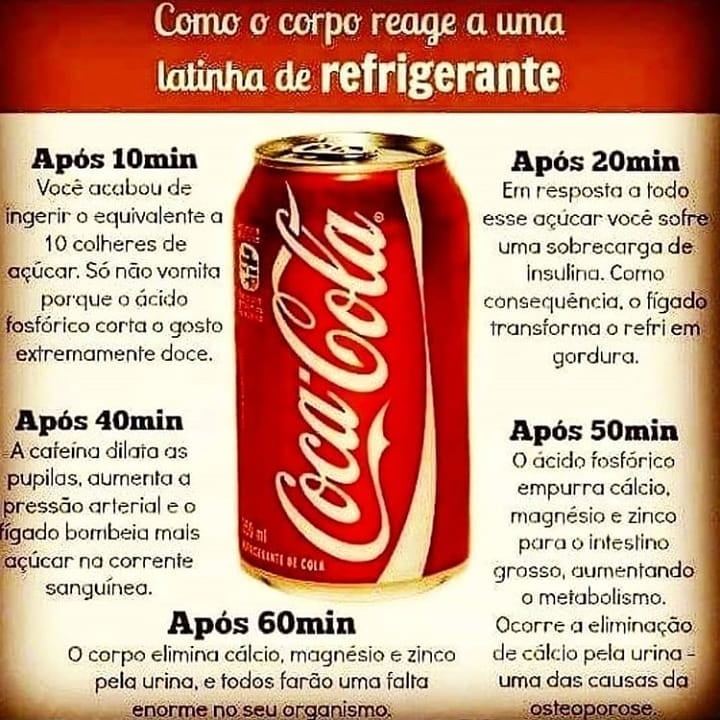O QUE ACONTECE NO CORPO DEPOIS DE BEBER UMA LATA DE REFRIGERANTE
O Que Acontece no Seu Corpo Após Beber Uma Latinha de Refrigerante?
Wesley Teixeira
9/10/20254 min read


🥤 O Que Acontece no Seu Corpo Após Beber Uma Latinha de Refrigerante?
Você já parou para pensar no que acontece dentro do seu corpo após consumir uma simples latinha de refrigerante? A maioria das pessoas não faz ideia dos impactos imediatos e silenciosos que essa bebida pode causar — e é exatamente por isso que esse post é tão importante.
⏱️ Após 10 minutos
Você acabou de ingerir o equivalente a 10 colheres de chá de açúcar. Isso é uma sobrecarga absurda para o organismo. O motivo de você não vomitar imediatamente é o ácido fosfórico, que mascara o sabor extremamente doce e impede a rejeição imediata.
🧬 Após 20 minutos
Seu corpo responde com uma explosão de insulina. O pâncreas entra em ação para tentar equilibrar os níveis de açúcar no sangue. O fígado, sobrecarregado, transforma esse excesso de glicose em gordura, especialmente na região abdominal.
🧠 Após 40 minutos
A cafeína começa a agir: dilata as pupilas, aumenta a pressão arterial e estimula o fígado a liberar ainda mais açúcar na corrente sanguínea. Você pode até sentir um pico de energia — mas é artificial e passageiro.
⚡ Após 50 minutos
O corpo tenta compensar o desequilíbrio: aumenta a absorção de cálcio, magnésio e zinco no intestino grosso. Isso acelera o metabolismo temporariamente, mas também prepara o terreno para uma perda significativa desses minerais.
🚽 Após 60 minutos
Você elimina pela urina cálcio, magnésio, zinco, sódio, eletrólitos e água. Ou seja, perde nutrientes essenciais para o funcionamento do corpo. Essa perda pode gerar queda de energia, irritabilidade e até vontade de consumir mais açúcar ou cafeína, criando um ciclo vicioso.
⚠️ Refrigerante Não É Só Uma Bebida — É Um Estímulo Químico Que Afeta Seu Corpo Inteiro
O consumo frequente de refrigerantes está associado a obesidade, resistência à insulina, doenças cardiovasculares, osteoporose e distúrbios neurológicos. E o mais preocupante: tudo isso começa com uma latinha aparentemente inofensiva.
Se você quer entender melhor como sua alimentação afeta sua saúde, eu posso te ajudar. Minhas consultas, mentorias e cursos são pensados para pessoas reais, que querem transformar seus hábitos com consciência, leveza e resultados duradouros.
Você merece viver com energia, clareza mental e saúde verdadeira. E eu estou aqui para te guiar nessa jornada.
Por isso, criei o e-book AÇÚCAR: O PRAZER QUE MATA para despertar e trazer consciência sobre os malefícios do consumo excessivo de alimentos e bebidas açúcaradas.
Me siga nas redes sociais. Aqui está meu INSTAGRAM & MEU CANAL DO YOUTUBE.
REFERÊNCIAS CIENTÍFICAS
ATKINSON, F. S.; FOSTER-POWELL, K.; BRAND-MILLER, J. C. International tables of glycemic index and glycemic load values: 2008.
AUGUSTIN, L. S. A low glycemic index meal before exercise improves endurance running capacity in men.
BHUPATHIRAJU, S. N. et al. Glycemic index, glycemic load, and risk of type 2 diabetes: results from 3 large US cohorts and an updated meta-analysis. 2014.
CHANDALIA, M. et al. Effects of dietary glycaemic index on adiposity, glucose homoeostasis, and plasma lipids in animals. 2004.
EBELING, P. et al. Pre-exercise carbohydrate meals: application of glycemic index. 1999.
FOSTER-POWELL, K. et al. Glycemic index, glycemic load, and chronic disease risk – a meta-analysis of observational studies. 2008.
KONG, A. et al. Effects of a low-glycemic load vs low-fat diet in obese young adults: a randomized trial. 2007.
MATTHEWS, D. R. et al. Effects of intensive glucose lowering in type 2 diabetes. 2008.
MAYER-DAVIS, E. J. et al. Low-glycaemic index diets in the management of blood lipids: a systematic review and meta-analysis. 2013.
PAREKH, N. et al. Effects of high vs low glycemic index of dietary carbohydrate on cardiovascular disease risk factors and insulin sensitivity: the OmniCarb randomized clinical trial. 2014.
REED, J. L. et al. Three 15-min bouts of moderate postmeal walking significantly improves 24-h glycemic control in older people at risk for impaired glucose tolerance. 2013.
WILLETT, W. C. The glycemic index: Reports of its demise have been exaggerated. 2015.
BAYS, H. E. Insulin resistance. A multifaceted syndrome responsible for NIDDM, obesity, hypertension, dyslipidemia, and atherosclerotic cardiovascular disease. 1991.
BLAIR, E. et al. Effect of diabetes in pregnancy on offspring: follow-up research in the Pima Indians. 2007.
BROWNLEE, M. Impaired insulin and insulin-like growth factor expression and signaling mechanisms in Alzheimer's disease – is this type 3 diabetes?. 2005.
CHEN, Y. et al. Relationship of insulin dynamics to body composition and resting energy expenditure following weight loss. 2015.
DECODE STUDY GROUP. Is there a simple way to identify insulin-resistant individuals at increased risk of cardiovascular disease?. 2005.
FERRANNINI, E. Insulin resistance and cardiovascular disease. 2008.
GALLAGHER, D. et al. A novel interaction between dietary composition and insulin secretion: effects on weight gain in the Quebec Family Study. 2008.
HEDLEY, A. A. et al. Trends in overweight from 1980 through 2001 among preschool-aged children enrolled in a health maintenance organization. 2006.
HJELM, K. et al. Long-term outcomes in mothers diagnosed with gestational diabetes mellitus and their offspring. 2007.
KAPLAN, R. M. et al. Thirty-one novel biomarkers as predictors for clinically incident diabetes. 2010.
KIM, J. et al. High intakes of milk, but not meat, increase s-insulin and insulin resistance in 8-year-old boys. 2004.
KLEIN, S. et al. Extended longevity in mice lacking the insulin receptor in adipose tissue. 2003.
KRAUS, W. E. et al. Comparison of 11 Human Insulin Assays: Implications for Clinical Investigation and Research. Clinical Chemistry, 2007.
LERNMARK, A. What if Minkowski had been ageusic? An alternative angle on diabetes. 1992.
LUSTIG, R. H. Myths about Insulin Resistance: Tribute to Gerald Reaven. 2019.
MCDONALD, R. Insulin secretory function in Type 2 diabetes: Does it matter how you measure it? Wiley Online Library, 2009.
CONTATOS
CURSOS
contato@wesleyteixeira.com
© 2025. All rights reserved.
MENU
REDES SOCIAIS
